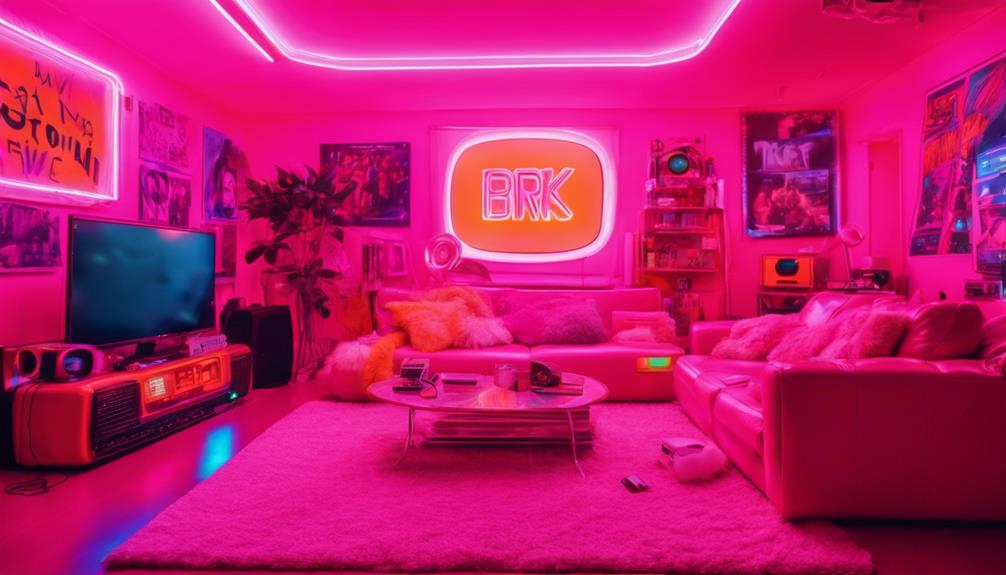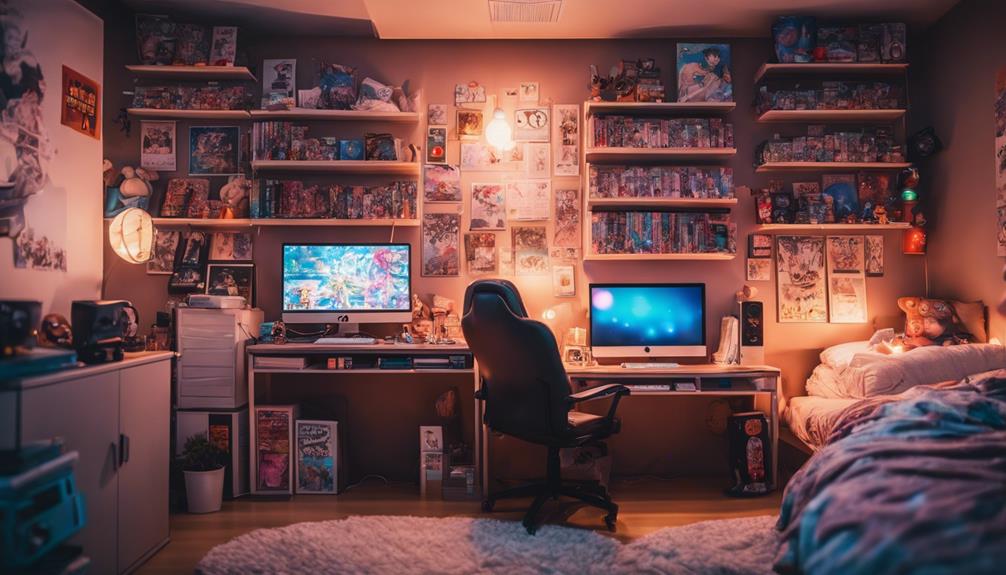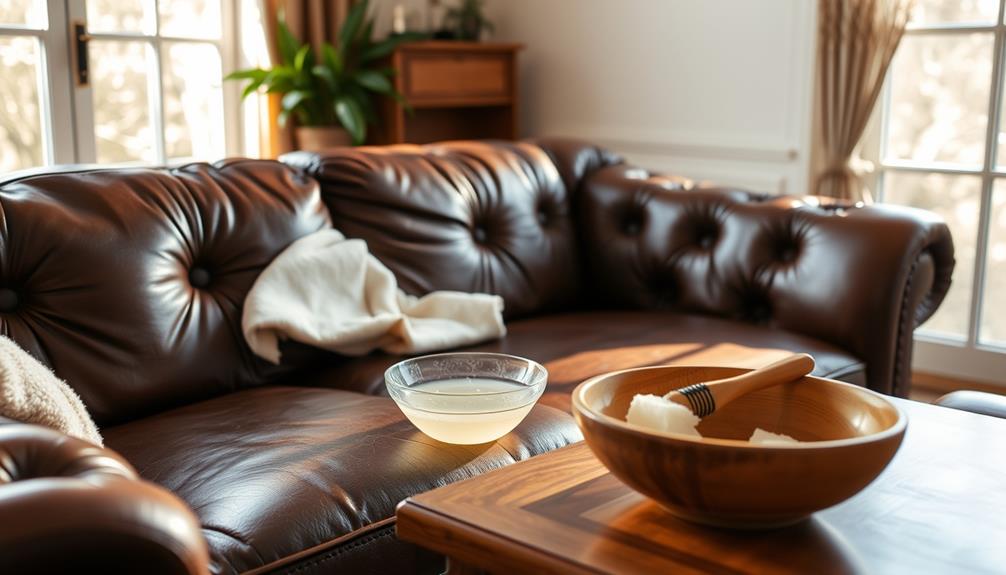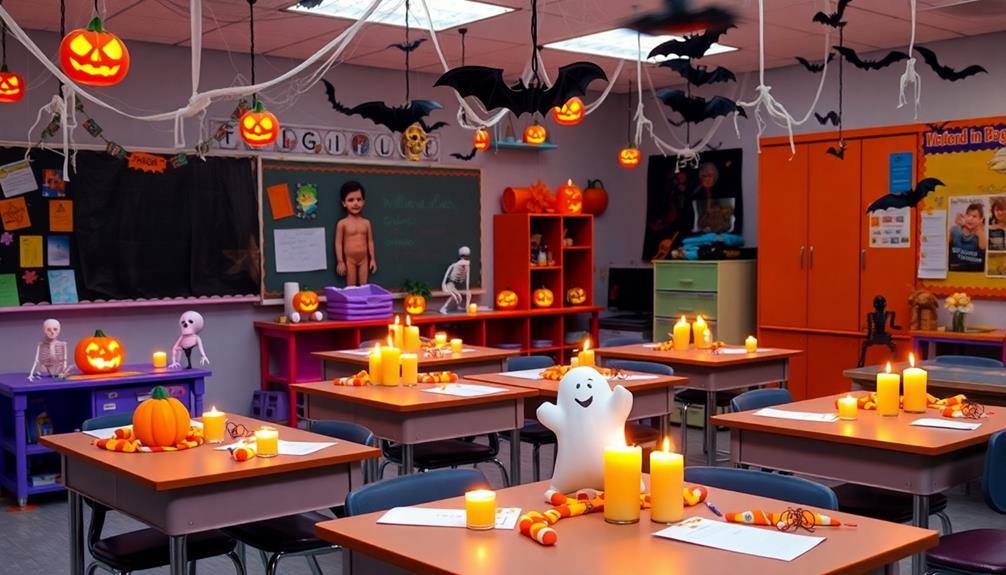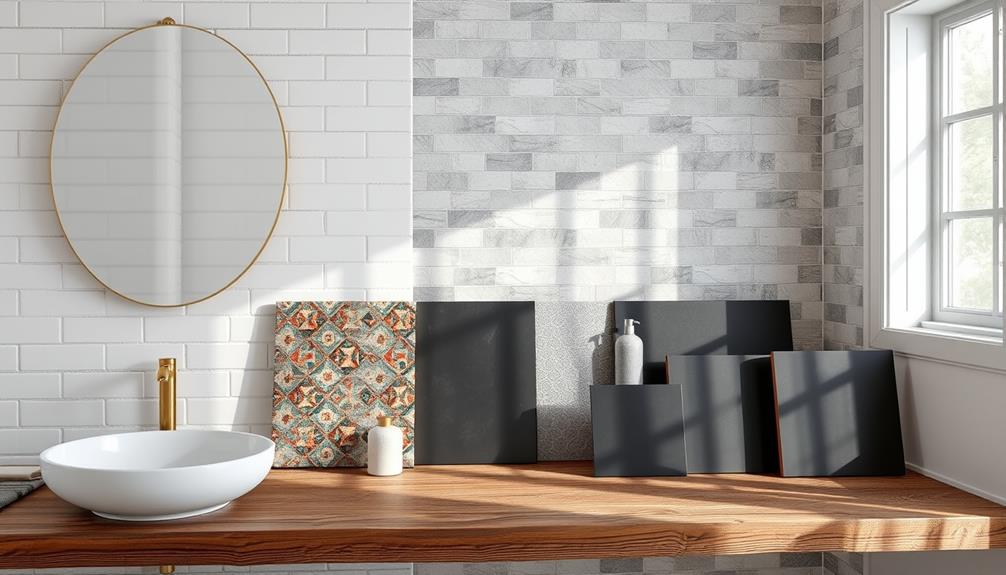Y2K room décor allows you to bring back the lively, nostalgic feeling of the early 2000s and amaze your friends. Consider vibrant color pairings such as hot pink and lime green, along with fun patterns like daisies and glitter. Integrate retro furniture such as bean bag chairs and lava lamps, and remember to include dynamic lighting with colorful LED strips. Enhance your space with decorative elements like glittery star stickers and heart hangings to create a whimsical atmosphere. You’ll turn your room into a playful retreat that everyone will enjoy. Discover more ideas to fully capture that early 2000s essence!
Key Elements
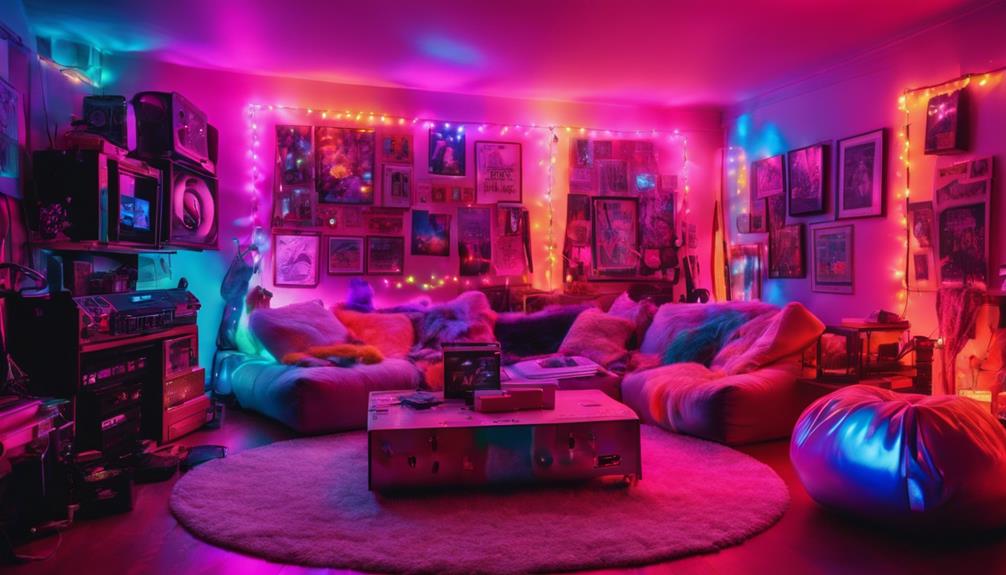
When you're setting up your Y2K room, the color scheme plays a vital role in capturing that nostalgic vibe.
Bright colors, unique materials, and playful textures work together to create an inviting and fun atmosphere.
Let's explore how these key elements can transform your space into a true reflection of early 2000s style.
Color Scheme
What defines the vibrant color scheme of Y2K room decor is its bold combination of bright colors, neon accents, and playful patterns.
You'll want to embrace hot pinks, lime greens, and vibrant purples to create an energetic atmosphere that captures the essence of the Y2K aesthetic room. These lively colors are essential for making your space feel fun and inviting.
Neon colors add a striking touch, perfect for accents that pop against softer backgrounds. Incorporating pastel shades can help balance these vibrant hues, giving your room a nostalgic vibe while keeping it visually appealing.
Don't forget about metallics and glitter, which were popular finishes back in the early 2000s; they'll enhance the playful and futuristic elements of your decor.
Lastly, consider adding flower patterns, especially daisies, to your color scheme. They embody the whimsical side of Y2K design and can tie your whole look together.
Materials
Incorporating vibrant materials like faux fur and colorful fabrics instantly elevates your Y2K room decor, adding a playful and cozy touch that defines the era's aesthetic. To truly capture the essence of Y2K decor, opt for bold colors like hot pink, lime green, and purple. Use these hues in your bedding and throw pillows to create an inviting atmosphere that screams early 2000s.
Don't forget to add decorative items that reflect the Y2K vibe. Beaded curtains and flower-patterned accessories, especially daisies, can effortlessly add charm and sparkle to your space. Additionally, consider multifunctional furniture pieces that align with the Y2K color palette. Statement chairs in bold hues or even inflatable furniture can introduce a fun, quirky element to your room.
Make sure to mix and match these materials to create a cohesive yet dynamic look. By layering colorful fabrics and incorporating playful accessories, you'll boost the nostalgic feel of your Y2K decor. Embrace the vibrant materials that defined the era, and watch as your space transforms into a lively homage to the early 2000s. Your friends will be impressed!
Textures
Textures play an essential role in defining your Y2K room decor, enhancing the cozy and vibrant atmosphere that characterizes the era. To achieve this, focus on incorporating faux fur textiles. A pink faux fur area rug or a cow spots fluffy blanket can instantly add warmth and a playful touch to your space.
Layering various patterns is key; consider bedding and decorative pillows featuring bold colors, like the Daisy Flower Decorative Pillow, to create a dynamic visual experience.
Mixing fabrics is another effective strategy. Combine plush, fleece, and cotton materials to enrich the tactile experience and evoke that nostalgic feeling from the early 2000s.
Don't forget about decorative accessories! Items like a heart-shaped mirror or neon signs not only serve functional roles but also contribute to the room's overall texture and vibe.
Essential Fixtures and Furniture
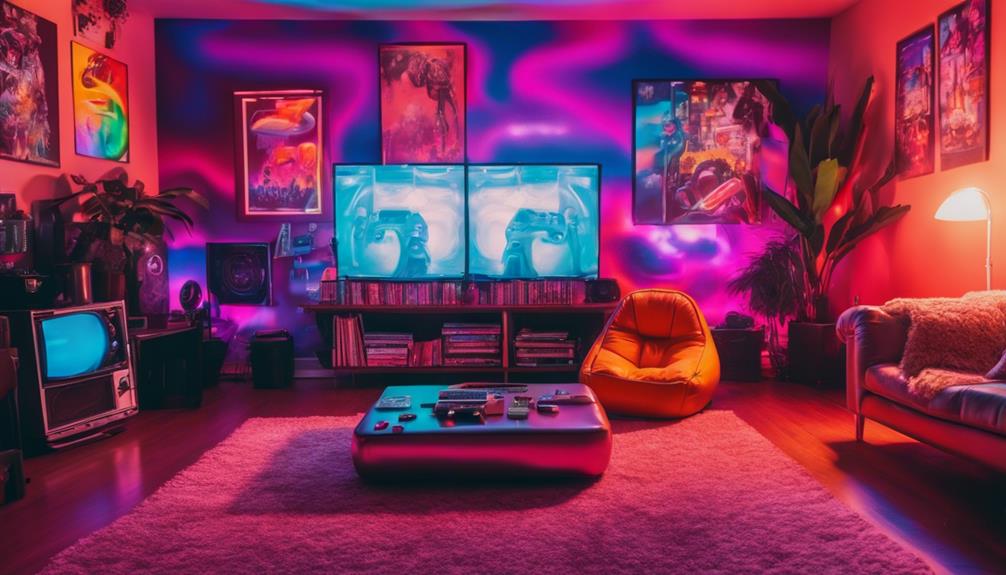
To create the ultimate Y2K vibe, you'll want to contemplate essential fixtures and furniture that embody the era's spirit.
A retro bean bag chair offers comfort and a playful aesthetic, while a vintage VHS storage unit adds a nostalgic touch.
Don't forget a classic retro lava lamp to bring that groovy glow into your space!
Retro Bean Bag Chair
Retro bean bag chairs bring vibrant color and a playful vibe to your Y2K room decor, making them an essential fixture for any nostalgic space. These chairs are a staple of early 2000s aesthetics, often showcasing eye-catching colors like hot pink and lime green. Their casual and comfortable design allows you to easily rearrange your room for different social gatherings, creating a cozy atmosphere that encourages lounging with friends.
Constructed from soft, durable fabrics, retro bean bag chairs not only enhance your room's nostalgic feel but are also easy to maintain. You can find them in various shapes and sizes, making it simple to incorporate them into your Y2K-inspired theme. Whether you want a bold focal point or a discreet seating option, a retro bean bag chair fits the bill perfectly.
Adding one of these chairs to your decor isn't just about style; it's about creating an inviting space where you and your friends can reminisce about the good old days. So go ahead, embrace the playful spirit of the early 2000s, and let a retro bean bag chair transform your room into a vibrant, nostalgic haven!
Vintage VHS Storage Unit
Adding a vintage VHS storage unit not only organizes your cherished tapes but also enhances the playful, nostalgic vibe of your Y2K room decor. By incorporating one of these units, you'll create a dedicated space for your collection while inviting a retro aesthetic that's hard to resist.
These storage units often come in colorful designs or unique shapes that seamlessly blend with the vibrant wall decor typical of the early 2000s. Look for options made from wood or plastic, featuring bold colors or patterns that can elevate your room's overall look.
Not only do they preserve your VHS tapes' condition, but they also make them easily accessible for those nostalgic movie nights with friends. Imagine the fun conversations that'll spark as you reminisce about favorite films from that era. Your vintage VHS storage unit can serve as a fantastic conversation starter, adding to the overall charm of your space.
Retro Lava Lamp
A retro lava lamp instantly transforms your space with its iconic design and soothing glow, making it a must-have for Y2K room decor. These mesmerizing fixtures, known for their slowly moving wax formations, create a calming ambiance that enhances your overall vibe. Available in vibrant shades like pink, blue, and green, a retro lava lamp aligns perfectly with the bold colors often seen in early 2000s aesthetics.
Standing at about 14.5 inches tall, this classic piece fits seamlessly on your bedside table or desk, complementing other Y2K decor elements like funky wall art and vintage posters. Beyond their decorative appeal, these lamps provide functional lighting, casting a soft illumination that makes your space feel cozy and inviting.
Incorporating a retro lava lamp into your room not only serves as a nostalgic nod to the past but also sparks conversations with friends who'll appreciate the throwback. With their timeless design and tranquil glow, retro lava lamps are essential fixtures that effortlessly elevate your Y2K-themed space.
Lighting Ideas
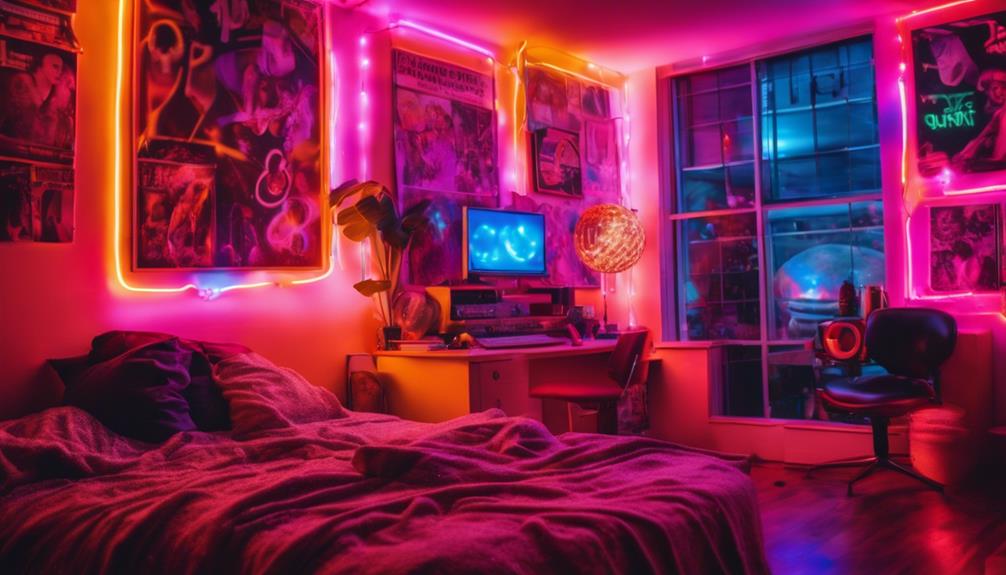
When it comes to lighting ideas for your Y2K room, you've got some fun options to explore.
Colorful LED strip lighting can create a vibrant atmosphere, while glowing neon wall art adds a bold statement.
Don't forget about a disco ball ceiling fixture to bring a playful touch, or a pastel glow table lamp for a softer vibe.
Colorful LED Strip Lighting
Colorful LED strip lighting instantly transforms your space, creating a vibrant atmosphere that captures the playful essence of Y2K decor. You can easily install these versatile strips along walls, ceilings, or even furniture, giving your room a bright colors makeover.
With customizable color options, you can switch between neon shades like hot pink, lime green, and electric blue, allowing you to match the lively vibe of early 2000s aesthetics.
Many LED strip lights come with remote control functionality or smartphone app integration, making it super convenient to adjust brightness and colors. Want to take it up a notch? Look for options with music sync capabilities, where the lights pulse and change in rhythm with your favorite tracks, enhancing that nostalgic party atmosphere.
Best of all, colorful LED strip lighting is budget-friendly, with quality options ranging from $10 to $30 USD. This means you can add a dynamic lighting element to your Y2K-themed room without breaking the bank.
Glowing Neon Wall Art
Glowing neon wall art instantly elevates your Y2K-themed room, adding vibrant pops of color and a playful atmosphere. These eye-catching pieces, like the Butterfly Wall Neon Sign for $22.99, come in multiple colors and enhance your space with a burst of energy. Not only do they serve as stunning decorative elements, but they also provide functional lighting, creating a warm and inviting ambiance.
The Lightning Bolt Neon Sign, available for $23.99, is particularly popular among e-Girl aesthetic enthusiasts, capturing that early 2000s nostalgia. Incorporating glowing neon wall art not only brightens your room but also creates fascinating focal points that draw the eye and evoke retro charm.
To maximize the impact, consider combining these neon pieces with fairy lights and other decorative elements. This layered lighting approach enhances your overall Y2K aesthetic, creating a cozy vibe perfect for hanging out with friends.
With glowing neon wall art, you'll not only impress your guests but also transport them back to the fun and funky era of the early 2000s. Don't miss the chance to infuse your space with this nostalgic flair!
Disco Ball Ceiling Fixture
Adding a disco ball ceiling fixture to your Y2K room decor instantly brings a playful vibe that complements the glowing neon wall art perfectly, reflecting the vibrant party culture of the early 2000s. These fixtures come in various sizes and styles, often featuring mirrored surfaces that create a dazzling light display when illuminated.
When you mount a disco ball in your space, you'll notice how it transforms the ambiance. Pair it with colored bulbs to enhance the retro aesthetic—think bright pinks, greens, and blues that resonate with the era. Not only does it serve as eye-catching decor, but it also acts as a fantastic conversation starter. Friends will be impressed with its iconic design, reminiscent of dance parties and carefree nights.
Incorporating a disco ball ceiling fixture can elevate your decor, making your room perfect for social gatherings. Whether you're hosting a small get-together or simply want to enjoy a fun atmosphere, this lighting choice adds a lively touch.
Pastel Glow Table Lamp
Transform your space with a Pastel Glow Table Lamp that not only provides soft, ambient light but also enhances the cozy, nostalgic vibe of early 2000s decor.
Available in a variety of pastel colors like bright pinks and soft purples, this lamp fits perfectly into your aesthetic room decor, allowing you to customize your space according to your taste.
Many models come with adjustable brightness settings, so you can easily create the ideal mood lighting for studying, relaxing, or hosting friends. Imagine dimming the lights to set a chill vibe for a movie night or brightening them up for a late-night creative session.
The sleek, modern design combines retro elements, making it a stylish blend that appeals to Y2K enthusiasts.
At prices ranging from $29.99 to $39.99 USD, the Pastel Glow Table Lamp is an affordable way to add both functionality and flair to your retro-themed room.
With its charming aesthetic, it's sure to impress your friends and transport you back to the vibrant vibes of the early 2000s.
Don't miss out on this essential piece for your nostalgic decor!
Decorative Elements
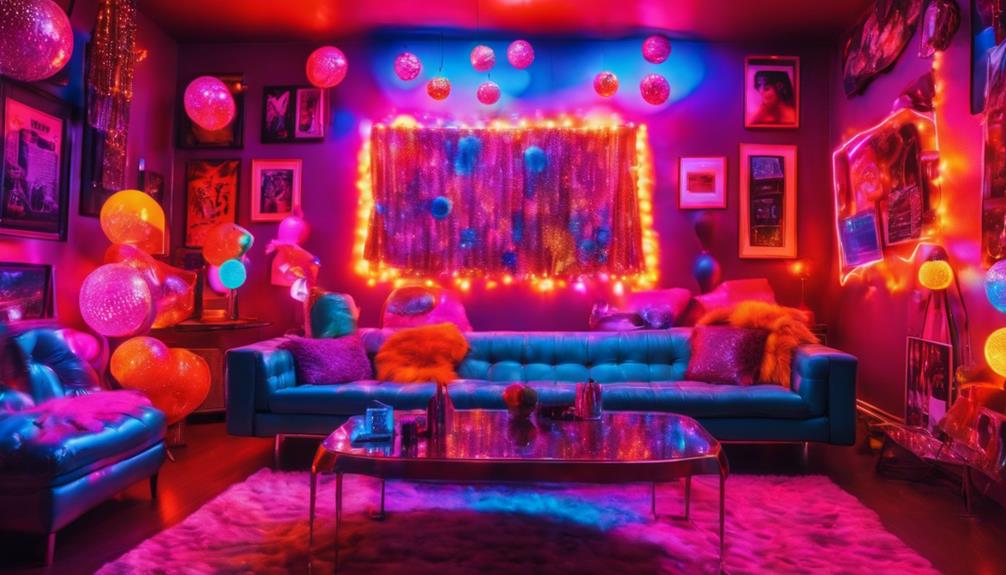
To truly capture the Y2K vibe, you'll want to add some glittery flair to your walls.
Glittery star wall stickers, butterfly wall decals, and heart wall hangings can transform your space into a nostalgic wonderland.
These decorative elements not only brighten your room but also reflect the playful spirit of the era.
Glittery Star Wall Stickers
Glittery star wall stickers effortlessly elevate your space, bringing a playful touch to any room while capturing the essence of Y2K aesthetics. These fun and versatile decorative elements instantly enhance your ambiance, reflecting the whimsical spirit of the early 2000s. Available in various sizes and colors, you can arrange glittery star wall stickers in countless patterns, allowing for personalized designs that resonate with your style.
Applying and removing these self-adhesive stickers is a breeze, making them perfect for renters or anyone who enjoys frequently changing their decor. You can easily create a dreamy, nostalgic vibe reminiscent of classic early 2000s bedrooms. As they catch and reflect light, glittery star wall stickers also create a sparkling effect that enhances your room's overall atmosphere.
Whether you're decorating a bedroom, a cozy nook, or even a workspace, these stickers are ideal for adding that unique touch. Perfect for both teens and adults, you'll impress your friends with this trendy choice. So, don't hesitate—grab some glittery star wall stickers and transform your space into a dazzling haven that celebrates the playful spirit of Y2K!
Glittery Butterfly Wall Decals
Add a splash of whimsy to your walls with glittery butterfly wall decals, which perfectly capture the vibrant essence of Y2K decor. These playful accents are a popular choice for anyone looking to enhance their room's design while embracing the cheerful aesthetic of the early 2000s.
Made from high-quality, self-adhesive vinyl, they're easy to apply and remove, so you won't have to worry about damaging your walls. Available in various sizes and colors, you can arrange these decals in creative patterns that reflect your personal style.
Whether you go for a delicate scattering or a bold cluster, they'll certainly add visual interest and a nostalgic vibe to your space. Plus, with prices ranging from $10 to $30, they offer an affordable way to transform your room without breaking the bank.
Incorporating glittery butterfly wall decals not only brightens your environment but also makes a fun statement that's sure to impress your friends. So why wait? Immerse yourself in the whimsical world of Y2K decor and let these delightful butterflies take flight on your walls!
Glittery Heart Wall Hangings
Transform your walls with charming glittery heart wall hangings that capture the playful spirit of Y2K decor.
These vibrant decorations were all the rage in the early 2000s, often crafted from sequins or glitter-coated materials. They add a lively touch to your space, making them perfect for enhancing the bright color palettes that define the Y2K aesthetic—think hot pinks and pastels.
You can easily DIY these heart-shaped hangings using craft supplies like foam hearts, glitter, and adhesive, allowing you to create personalized designs that reflect your unique style.
Not only do they serve as eye-catching focal points, but they also evoke nostalgia for the pop culture and fashion trends of the early 2000s.
Flooring
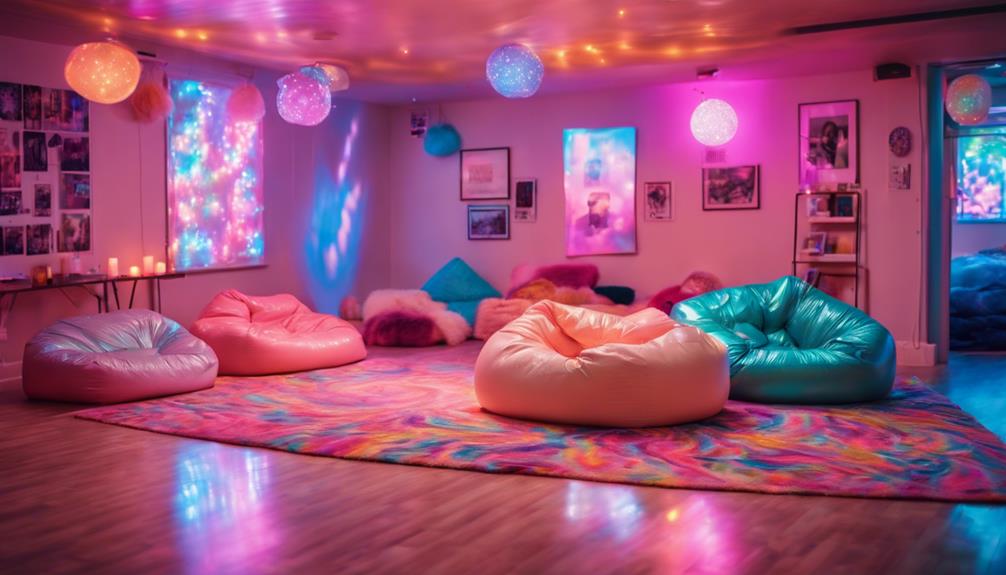
When it comes to flooring for your Y2K room, you'll want to contemplate vibrant options like checkered vinyl floor tiles, pastel pink carpet tiles, or even bright yellow rubber flooring.
These choices not only capture the playful spirit of the early 2000s but also add a unique flair to your space.
Checkered Vinyl Floor Tiles
Checkered vinyl floor tiles bring a vibrant retro vibe to your Y2K room decor, making them a stylish choice for any space. These tiles offer a unique style that captures the playful spirit of the early 2000s, with bold patterns that can transform your room into a nostalgic haven.
Available in various sizes and colors, you can easily customize your flooring to fit your theme, whether it's a classic black-and-white contrast or bright neon shades that pop.
One of the best aspects of checkered vinyl floor tiles is their durability. Made from sturdy materials, these tiles are easy to clean and maintain, perfect for high-traffic areas in your home. You won't have to worry about spills or stains ruining your vibrant decor.
Plus, installation is a breeze; you can tackle it as a DIY project with just adhesive and a utility knife.
With checkered vinyl floor tiles, you'll not only achieve a retro look, but you'll also create a fun, dynamic atmosphere that impresses your friends. So, get ready to embrace the Y2K aesthetic and let your flooring shine!
Pastel Pink Carpet Tiles
Adding pastel pink carpet tiles to your Y2K room decor introduces a soft, vibrant touch that beautifully complements the boldness of checkered vinyl floor tiles. These tiles not only enhance the overall aesthetic but also create a cozy atmosphere, inviting you to kick off your shoes and relax. Made from durable materials, pastel pink carpet tiles guarantee longevity while providing a plush surface for walking or sitting.
One of the best features of these tiles is their versatility. You can install them in various configurations, allowing you to express your personal style with creative designs. Whether you arrange them in a checkerboard pattern or create unique shapes, the options are endless.
Pastel pink carpet tiles also mesh seamlessly with other Y2K decor elements, such as vibrant bedding sets and colorful accessories. This harmonious combination helps to evoke a nostalgic vibe, making your space feel both fun and inviting.
Plus, maintenance is a breeze. Many pastel pink carpet tiles are stain-resistant and can be easily kept clean with regular vacuuming or spot cleaning. Transform your room with these delightful tiles and impress your friends with your chic Y2K style!
Bright Yellow Rubber Flooring
Bright yellow rubber flooring instantly brings a lively energy to your Y2K room decor, setting the stage for a vibrant and inviting atmosphere. This flooring choice is perfect for recreating that nostalgic early 2000s aesthetic, adding a cheerful pop of color that can make any space feel dynamic. Its durability guarantees it stands up to everyday wear, while the soft surface offers comfort for long hours spent in the room.
Not only is bright yellow rubber flooring water-resistant and easy to clean, but it also supports hassle-free maintenance—essential for keeping your retro vibe intact. Plus, the reflective qualities of this hue enhance the overall brightness of the room, making it even more welcoming.
You can play with various textures and patterns in your interior design, allowing this flooring to harmonize beautifully with other Y2K elements like plush rugs and colorful furniture. By incorporating graphic design elements that complement the flooring, you can create a cohesive look that impresses your friends and takes you back to the fun and bold era of the early 2000s.
Bright yellow rubber flooring is a fantastic foundation for your Y2K-inspired space!
How Can Y2K Room Decor Bring Nostalgia and Impress Guests?
Step back in time with aesthetic y2k room decor nostalgia flair. Bring back the early 2000s with vibrant colors, plastic furniture, and funky patterns. Impress guests with a nostalgic vibe that transports them to a simpler era. Embrace the Y2K aesthetic and infuse your space with retro charm.
Conclusion
Bringing back Y2K room decor is all about embracing nostalgia while adding your personal touch.
By incorporating essential fixtures, playful lighting, and quirky decorative elements, you can create a space that not only reflects the early 2000s but also impresses your friends.
Don't forget to choose the right flooring to tie everything together.
So go ahead, immerse yourself in those vibrant colors and unique styles, and transform your room into a fun, retro haven that sparks joy!
